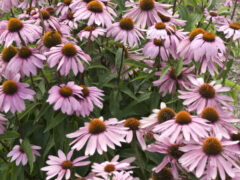
hyacinth bean vine
Dolichos lablab
With striking foliage, flowers, and seed pods, this vigorous grower covers fence and arbor quickly … Continued
 Hummingbirds, bees and butterflies are well-known pollinators, but there are thousands of unsung pollinator heroes, including moths, wasps, flies, and beetles, many mammals, birds, and reptiles, who also take on the job.
Hummingbirds, bees and butterflies are well-known pollinators, but there are thousands of unsung pollinator heroes, including moths, wasps, flies, and beetles, many mammals, birds, and reptiles, who also take on the job.
Pollinators move from plant to plant, fueling up with pollen and nectar from blooming trees, shrubs, perennials, annuals, vegetable plants, and herbs. As they move, the pollinators transport and deposit pollen, fertilizing plants and allowing them to reproduce.
Pollinator plants can be native and non-native, but not all flowering plants are equal when it comes to providing the highest quality protein-rich pollen. Many hybrids don’t even produce pollen at all. The following list includes pollen-rich plants to include in your garden to provide pollinators with food.
Local butterfly expert Lenora Larson has created these informational handouts. You can download them here!
• Butterflies: Flying Flowers in your Garden!
• A Vital Connection: Native Plants and Butterflies
• Long Lips Farm Caterpillar Foodplants
• Butterfly Bartending: Nectar Flowers
• Long Lips Farm: Selected Butterfly Nectar Flowers
• Bee Friendly: Plants for Bees and Other Pollinators
Since 1970 the population of North American birds has dropped nearly 30% — almost three billion birds have vanished from our forests, grasslands, and backyards in less than a human lifetime. It’s a chilling fact that makes it clear that we must act as individuals to help ensure their survival.
Most importantly, ninety-six percent of all terrestrial bird species rear their young on insects so it is also important to grow plants that feed insects to provide a well-rounded habitat in your garden.


Dolichos lablab
With striking foliage, flowers, and seed pods, this vigorous grower covers fence and arbor quickly … Continued

Viburnum plicatum f. tomentosum 'Mariesii'
This is a very large and beautiful shrub! The striking layered horizontal branching on this … Continued

Phlox pilosa
These long-blooming perennials thrive in rocky or dry open woods, meadows, and prairies. An upright … Continued

Dianthus barbatus Barbarini™ Red
An old-fashioned cottage garden self-seeding biennial plant, this dwarf hybrid strain produces showy clusters of … Continued

Echinacea pallida
Echinacea pallida is easily grown in average, dry to medium, well-drained soil in full sun … Continued

Echinacea 'Cheyenne Spirit'
Echinacea ‘Cheyenne Spirit’ grows vivid colors in clear tones of purple, pink, scarlet, yellow, cream, … Continued

Echinacea purpurea 'Pow Wow White'
Single white flowers with large golden cones atop 18-24″ tall stems. The hardiest white we’ve … Continued

Echinacea purpurea 'PowWow Wild Berry'
Echinacea purpurea ‘PowWow Wild Berry’ is an AAS Winner that differs from other coneflowers in … Continued

Echinacea 'Sombrero Granada Gold'
Large golden yellow blooms abound from late spring throughout summer. This sturdy compact selection was … Continued

Echinacea purpurea ‘Magnus’
Perennial Plant Association 1998 Perennial Plant of the Year! The classic purple coneflower with rose-pink … Continued

Echinacea purpurea 'Mellow Yellows'
An array of blooms in shades of yellow is displayed at once, opening deep mango … Continued

Echinacea angustifolia
This Great Plains native blooms in late spring to mid-summer. It is found growing in … Continued